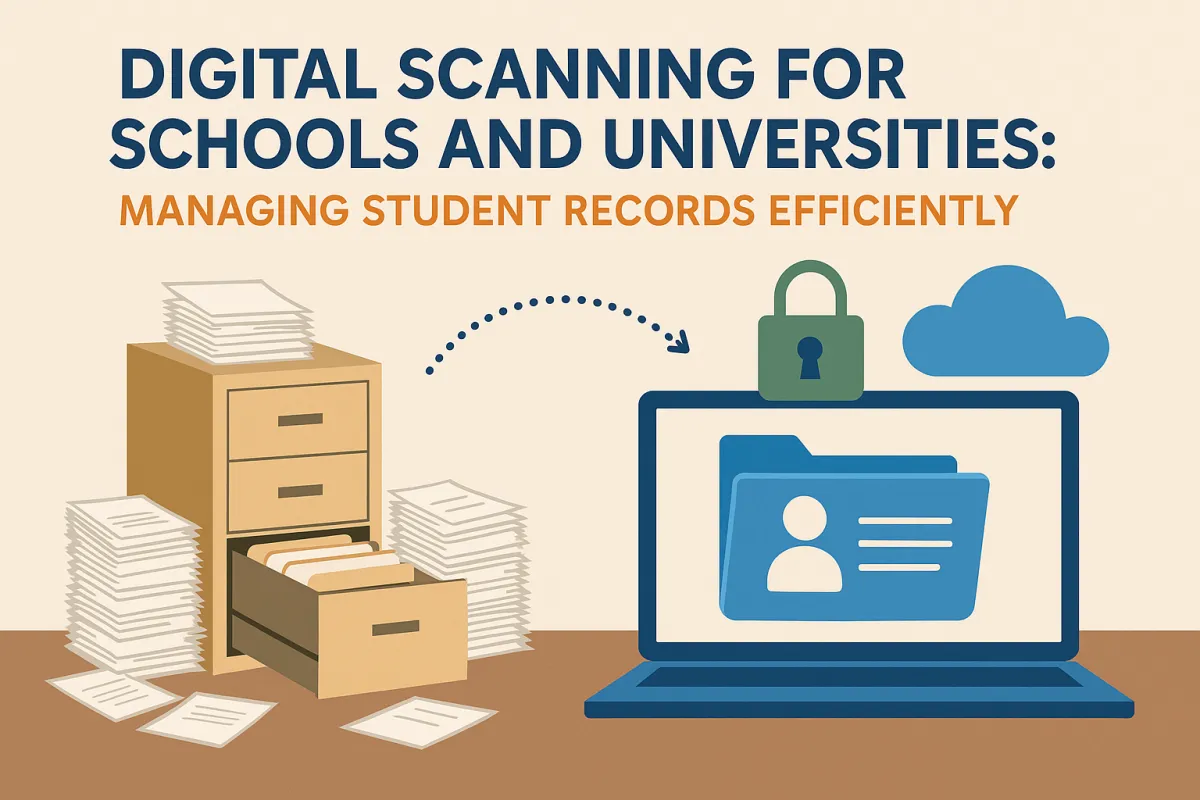
Digital Scanning for Schools and Universities: Managing Student Records Efficiently
By: USA IMAGING, Inc.
Walk into almost any school office or university records department, and you’ll see the same thing: filing cabinets, boxes, and shelves stacked with paper records. From enrollment forms and transcripts to financial aid files and medical waivers, student records are everywhere—and they’re often overflowing.
The problem? Paper is slow, fragile, and hard to manage at scale. That’s why more and more schools and universities are turning to digital scanning as a smarter, more secure way to manage student records. It’s not just about “going paperless.” It’s about improving efficiency, meeting compliance requirements, and freeing up valuable space and staff time.
Why Student Records Are So Complicated
Unlike a typical office file system, student records are complex. A single student might have:
Enrollment applications
Academic transcripts
Attendance records
Standardized test scores
Health and immunization forms
Financial aid documents
Disciplinary files
Graduation certifications
Multiply that by hundreds—or thousands—of students, and you quickly see the challenge. Not only do these records need to be kept secure and confidential, but they also need to be retrieved quickly whenever a student, parent, or administrator makes a request.
With paper files, that often means digging through cabinets, waiting for staff to pull records, and dealing with misplaced or misfiled documents. With digital scanning, that process is reduced to seconds.
The Benefits of Scanning for Schools and Universities
1. Faster Access for Staff and Students
Need a transcript for a transfer or job application? With scanned records, staff can retrieve it instantly using a search function, rather than thumbing through a paper file. That means students get what they need faster, and staff spend less time chasing paper.
2. FERPA and Compliance Protection
Schools are legally required to protect student privacy under FERPA (Family Educational Rights and Privacy Act). Paper files can easily be misplaced, left on desks, or accessed by unauthorized individuals. With digital scanning, files can be secured with password protection, encryption, and access controls so only authorized staff see sensitive information.
3. Space Savings
School offices and universities often dedicate entire rooms to filing cabinets. By scanning records, those cabinets can be replaced with a few secure servers—or even better, cloud storage. That frees up space for classrooms, labs, or student services.
4. Disaster Protection
What happens if a flood, fire, or natural disaster damages paper records? They’re gone. Digitized records, on the other hand, can be backed up to multiple secure locations. Even in the worst-case scenario, the files are safe.
5. Long-Term Preservation
Paper deteriorates over time—especially older documents like grade books or student ledgers that might already be yellowing. Scanning preserves these historical records in crisp, high-resolution digital formats that will last indefinitely.
6. Workflow Integration
Digital student records can be integrated with learning management systems (LMS), student information systems (SIS), and other administrative tools, making them far more useful than static paper files.
How the Process Works for Schools
At USA IMAGING, Inc., we’ve designed a process specifically for educational institutions:
Pickup or On-Site Scanning – We securely transport records or bring equipment to your campus.
Preparation – Staples, clips, and damaged pages are addressed to ensure smooth scanning.
Scanning – High-speed scanners convert records into digital images (PDF, TIFF, or JPG).
OCR & Indexing – Optical Character Recognition makes every document searchable. Indexing adds metadata such as student name, ID, or graduation year.
Quality Control – Every document is double-checked for accuracy.
Secure Storage Delivery – Files are delivered via encrypted hard drives, secure cloud access, or both.
Optional Shredding – Once digitized, paper copies can be securely shredded to save space.
Real-World Example
One university we worked with had an entire basement filled with student files dating back to the 1960s. Staff spent hours each week trying to find the right files for alumni requests, transcript verifications, and graduate school applications.
After scanning, all records were fully indexed and searchable by student ID and name. Requests that used to take hours were completed in under five minutes. The university also reclaimed a large portion of the basement and converted it into a new student resource center.
The Future of Records Management in Education
Digital scanning isn’t just a convenience—it’s quickly becoming the standard. As more schools embrace online learning, hybrid classrooms, and digital student services, managing student records electronically is the logical next step.
With searchable, secure, and easily accessible records, administrators can serve students faster, comply with regulations more easily, and operate with greater efficiency.
Final Thought
Paper records served schools for decades, but in today’s world, they slow down service, waste space, and put valuable data at risk. Digital scanning offers a smarter, safer, and more efficient way to manage student information.
If your school or university is still buried in paper files, now is the time to make the transition.
📞 Contact Us: 858-513-6565
📩 Request a Quote: Click Here
